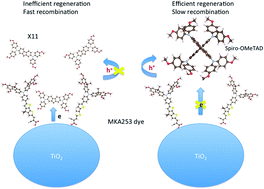The combination of a new organic D–π–A dye with different organic hole-transport materials for efficient solid-state dye-sensitized solar cells†
Abstract
A new organic donor–π–acceptor sensitizer MKA253 has been applied for highly efficient solid-state dye-sensitized solar cells (ssDSSCs). Using 2,2′,7,7′-tetrakis(N,N-di-p-methoxyphenyl-amine)9,9′-spirobifluorene (Spiro-OMeTAD) as the hole transport material (HTM), an excellent power conversion efficiency of 6.1% was recorded together with a high short-circuit current of 12.4 mA cm−2 under standard AM 1.5G illumination (100 mW cm−2). Different combinations of dyes and HTMs have also been investigated in the ssDSSC device. The results showed that small molecule HTM based devices suffer from comparably high electron recombination losses, thus causing low open-circuit voltage. In addition, photo-induced absorption (PIA) spectroscopy showed that the small-molecule HTMs lead to more efficient dye regeneration in comparison with Spiro-OMeTAD, despite a lower thermodynamic driving force. The results of this study also show that optimized energy levels for the dye–HTMs could be a vital factor for highly efficient ssDSSCs.


 Please wait while we load your content...
Please wait while we load your content...